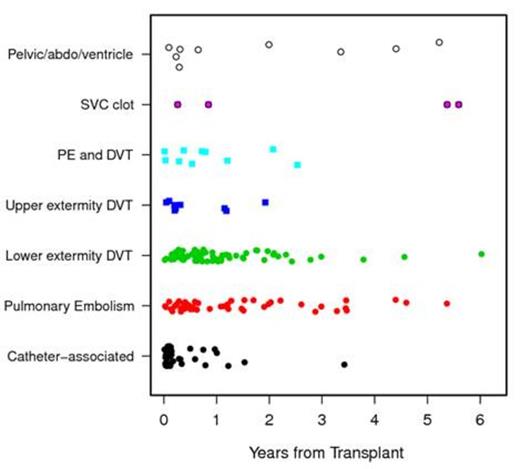Abstract

Introduction: Although venous thromboembolism (VTE) after allogeneic hematopoietic stem cell transplantation (HSCT) is known to occur, there are currently limited data on its incidence, risk factors and outcomes. Studies that have examined VTE after HSCT have been small and not adequately able to address clinical risk factors including graft-versus-host disease (GVHD). We describe VTE incidence, characteristics, risk factors and outcomes in a large cohort of patients undergoing allogeneic HSCT.
Methods: We identified all patients who underwent allogeneic HSCT between January 1, 2002 and December 31, 2013 at Dana Farber Cancer Institute/Brigham and Women's Hospital (DFCI/BWH). Using pharmacy records and medical chart review, patients who received systemic anticoagulation (low-molecular weight heparin, warfarin, fondaparinux, and dabigatran) for VTE were identified. All VTE events were confirmed by radiologic imaging (ultrasound, CT, MRI or V/Q scan). VTE was defined as catheter-associated, pulmonary embolism (PE), lower extremity deep vein thrombosis (DVT), upper extremity DVT, superior vena cava (SVC) thrombosis or other (pelvic, abdominal, or ventricular thrombosis).
Results: 2276 patients who underwent initial allogeneic HSCT at DFCI/BWH were identified, with a median follow-up time of 50 months (range 4-146) among survivors. 190 patients (8.3%) developed VTE. The 1 and 2-year cumulative incidence of all VTE were 5.5% (95% CI 4.6-6.5%) and 7.1% (95% CI 6.1-8.2%) respectively. There was no difference in age, gender, body mass index, diagnosis, disease status at time of HSCT, conditioning regimen intensity, donor type (HLA matched/mismatched, related/unrelated, or cord blood), or graft source (bone marrow or peripheral blood) between HSCT recipients with and without VTE.
Amongst the 190 patients who developed VTE, 65 (34.2%) were lower extremity DVT, 48 (25.3%) were catheter-associated, 45 (23.7%) were PE, 10 (5.3%) were PE and DVT, 9 (4.7%) were upper extremity DVT, 9 (4.7%) were other DVT, and 4 (2.1%) were SVC thrombosis. Catheter-associated DVT occurred at a median of 1.1 months (range 0.1-41.1) after HSCT, which was significantly shorter than other types of VTE (figure, p<0.0001). Only 9 patients (4.7%) were not on systemic immune suppression at time of VTE. 98 patients (51.6%) had active GVHD at time of VTE, while 28 (14.7%) had a history of GVHD, still on immune suppression at time of VTE. For patients with active or previous GVHD, the most prevalent organ involvement was skin (38.4%).
In a multivariable Cox model treating VTE and GVHD as time-dependent variables, VTE was associated with increased non-relapse mortality (HR=1.47; 95% CI 1.07-1.98), but not relapse (HR=0.98, 95% CI 0.69-1.34), progression-free survival (HR=1.21, 95% CI 0.94-1.57) or overall survival (HR=1.07, 95% CI 0.86-1.34). Non-relapse mortality remained as a significant association with VTE when catheter-associated VTE were excluded (HR=1.67; 95% CI 1.14-2.37). In a multivariable model to identify potential risk factors for VTE, both acute and chronic GVHD were independently associated with developing VTE (see table). In patients who developed GVHD, 8% had a subsequent VTE: 7% non-catheter-associated and 1% catheter-associated.
Conclusion: Venous thromboembolism is a prevalent complication of allogeneic HSCT that increases non-relapse mortality risk. Both acute and chronic GVHD are associated with an increased risk of developing VTE. Further analysis is needed to identify HSCT patients with the highest risk for VTE who might benefit from VTE prophylaxis.
Multivariable Cox model stratified by conditioning intensity for identification of potential risk factors for VTE
| Prognostic Factor . | HR (95% CI) . | p-value . |
|---|---|---|
| Age: >=70 years vs <70 years | 0.26 (0.04-1.85) | 0.18 |
| Male vs Female | 0.97 (0.72-1.29) | 0.81 |
| BMI: >=30 vs <30 | 1.07 (0.79-1.46) | 0.65 |
| Matched related vs unrelated donor | 1.09 (0.79-1.49) | 0.61 |
| Mismatched vs matched donor | 0.99 (0.62-1.59) | 0.96 |
| Myeloid diagnosis | 0.81 (0.60-1.10) | 0.18 |
| GVHD prophylaxis: Sirolimus vs No Sirolimus | 0.91 (0.68, 1.24) | 0.56 |
| Prior acute GVHD | 2.02 (1.47-2.77) | <0.0001 |
| Prior chronic GVHD | 2.30 (1.52-3.48) | <0.0001 |
| Prognostic Factor . | HR (95% CI) . | p-value . |
|---|---|---|
| Age: >=70 years vs <70 years | 0.26 (0.04-1.85) | 0.18 |
| Male vs Female | 0.97 (0.72-1.29) | 0.81 |
| BMI: >=30 vs <30 | 1.07 (0.79-1.46) | 0.65 |
| Matched related vs unrelated donor | 1.09 (0.79-1.49) | 0.61 |
| Mismatched vs matched donor | 0.99 (0.62-1.59) | 0.96 |
| Myeloid diagnosis | 0.81 (0.60-1.10) | 0.18 |
| GVHD prophylaxis: Sirolimus vs No Sirolimus | 0.91 (0.68, 1.24) | 0.56 |
| Prior acute GVHD | 2.02 (1.47-2.77) | <0.0001 |
| Prior chronic GVHD | 2.30 (1.52-3.48) | <0.0001 |
Median time to VTE: Catheter-associated=1.1 mos, PE=13 mos, lower extremity DVT=9 mos, upper extremity DVT=2.7 mos, PE and DVT=7.5 mos, SVC=37.3 mos and other DVT=7.8 mos (p<0.0001).
Armand:Merck: Consultancy, Research Funding; Bristol-Myers Squibb: Research Funding; Infinity Pharmaceuticals: Consultancy.
Author notes
Asterisk with author names denotes non-ASH members.

This icon denotes a clinically relevant abstract


This feature is available to Subscribers Only
Sign In or Create an Account Close Modal